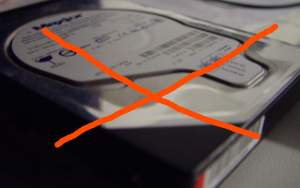Yesterday, the 40GB hard disk in my dogsbody machine was fine. Booted it this evening to make sure everything I needed was on it to teach people PHP stuff later, and it said nasty things about “zero length partition” when trying to mount /home, /var etc.
Rebooted. Failed to mount /. Uh-ohhhh...
Rebooted. What hard disk?
 Gone in 60 seconds. I am seriously unimpressed. Less than 2 years old, less than 1000 run-hours under its belt. Rust in pieces, Maxtor DiamondMax Plus 8 40GB serial number E1FESHAE.
Gone in 60 seconds. I am seriously unimpressed. Less than 2 years old, less than 1000 run-hours under its belt. Rust in pieces, Maxtor DiamondMax Plus 8 40GB serial number E1FESHAE.
As with all hardware which lets me down badly, this one’s not getting tossed, it’s being carefully given to my 10yo nephew Christopher. What he does to them is... unpleasant. The plan is that when word gets back to the survivors, they won’t so much as blip for the next couple of decades.
Comments